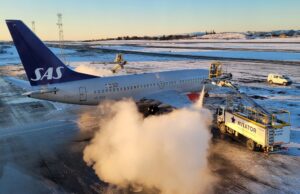Feb 07, 2024

Winter operations in the aviation industry can be incredibly demanding, especially in regions where temperatures plummet and snow blankets the landscape. Aviator Airport Alliance, a full-range provider of aviation services at 15 airports across the Nordics, has set itself a goal of becoming net-zero by 2030, and this winter was proof that while operating in the Nordic countries, it’s an even more difficult task than anywhere else, requiring an especially strong commitment to a sustainable future.
Jo Alex Tanem, CEO of Aviator Airport Alliance, shares his insights about the unique challenges posed by cold winters and how fighting them looks like when you’re taking a sustainable path.
READ: Aviator further strengthens partnership with Turkish Airlines
2023 Winter Beating Records
According to Tanem, as most of the company’s emissions come from the usage of vehicles and other equipment when delivering ramp service or de-icing to airline customers, Aviator has been paying special attention to the efficiency of operations and energy savings. However, this winter has been particularly challenging, with fluctuating temperatures, heavy snowfall, and freezing rain creating difficult conditions. “To make an example, during Christmas, Bardufoss Airport (BDU) experienced bone-chilling temperatures as low as -28 degrees Celsius, followed by a sudden rise to +6 degrees. The lowest temperature in Norway dropped to -44 degrees Celsius. However, despite the challenging weather conditions, de-icing operations hit a record high with nearly 5000 events: Stockholm Arlanda Airport (ARN) had 1800 de-icing events, and Helsinki Airport (HEL) had 1462 events,” explains Tanem.
He says that heavy snowfalls in all the Nordic regions didn’t help either – for example, in total, there were 26 days of snowfall in December in Stockholm and 27 days in Helsinki.
READ: Aviator strengthens partnership with Air France–KLM
Managing HVO Caused Challenges During Wintertime
Even though Aviator’s CEO firmly believes that by incorporating sustainable fuel into the company’s operations and transitioning the Ground Support Equipment (GSE) fleet to electric power, the company can become carbon neutral even by 2026, one of the specific challenges they faced this winter was related exactly to the use of HVO (Hydrotreated Vegetable Oil) as an alternative fuel. HVO is known for its sustainability benefits but can pose difficulties in extremely cold weather.
Tanem explains, “On those days when the temperature dropped below -20 degrees, there have been some difficulties with equipment that uses HVO. Usually, it is equipment that is not used so often, like the Airstarter and mobile Ground Power Units. The problems have been with fuel filters freezing and not starting. This is a challenge for us because we don’t have any place inside to park our equipment, and that is the main contributing factor.”
Now Aviator uses HVO in all their diesel-powered equipment. The split between electrical and diesel is around 65% electric and 35% diesel with HVO. HVO’s main advantage, according to Tanem, lies in sustainability, significantly reducing emissions.
Aviator began implementing HVO in their equipment in 2019-2020 on a small scale, and its usage has steadily increased over the last two years. Aside from eliminating fossil fuels from operations, company has also been focusing on performing fully green turnarounds as a part of the goal to reduce its impact on the environment.
The post Challenging winter operations test Aviator’s sustainable aviation goals appeared first on AIR CARGO WEEK.
Go to Source
Author: Edward Hardy





